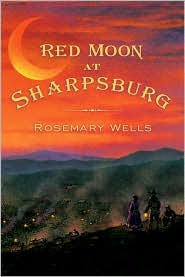Red Moon at Sharpsburg by Rosemary Wells, 256 pp RL MIDDLE GRADE

Although it is two-hundred and fifty-six pages long, Rosemary Wells' Civil War story Red Moon at Sharpsburg reads more like an epic saga along the lines of Margaret Mitchell's Gone With the Wind in terms of the multitude of experiences the main character lives through over the course of the fours years during which the story takes place. Wells' main character and narrator, India Moody definitely fits the mold of the headstrong, sometimes willful, self-determined historical heroine who often rescues the men and boys of the story. She is also reminiscent of the subject of Wells' book Mary on Horseback. The real life Mary Breckenridge was a brave, headstrong woman who established health care for the poorest of the poor living in the Appalachian Mountains with her Frontier Nursing Service, founded in 1925.
A bit of back story at beginning of the novel reveals the incident that ties the main families in the story, the wealthy Trimbles, the hard working Moodys and Micah and Esther, black slaves freed by the Trimbles. From that point on their lives and fates are intertwined as they try to survive the war that rages around them in Berryville, Virginia. Beginning in 1861 when India is twelve, we watch as all the young men, and even the older, including India's father, join the army. As the days then years pass the Moodys and Trimbles suffer grave losses and severe living conditions. As the hardships increase, Wells' descriptions become more intense and vivid. You feel like you can see and smell everything that India experiences right along with her, from the stink of the unwashed soldiers to the chemical odor of the experiments she observes Emory Trimble conduct. Early on, India's dearest friend Julia and her wealthy Quaker parents move to Ohio to get out of the way of the destruction that is surely on its way. India misses Julia dearly, even though they are opposites, India being very studious and reading novels like Charles Dickens' Great Expectations outside of school for extra work and Julia loving clothes and boys, she considers traveling with Julia to her relative's home. However, her sense of responsibility to her mother, father, grandfather and baby brother is strong, especially after her father leaves to work in the ambulance corp. India manages to resist the knowledge, provided by Julia who now has a brother studying law there, that Oberlin College admits women and has a work study program that would allow India to pay for her tuition, but her desire to go there remains even during her darkest days.
India does get to spend time at Longmarsh, the Trimble's estate, when, very early on in the war, the town's teacher enlists and is killed. Emory, the youngest of the three Trimble sons, is asthmatic and cannot serve in the army and has been away at University studying medicine. He tutors India in the glass greenhouse, built to ease his breathing, that has become his laboratory for the study of chemistry and biology, particularly the causes of infection. Ready to teach India "scriptures, household economics, handwriting, declamation," as her mother insist, she instead proves to be insatiably curious about and adept at learning the sciences that Emory is studying. Gradually, India becomes indispensable to Emory, helping with his research and transcribing his notes. Through her friendship with Emory and his with a visiting German doctor, the Europeans notably ahead in the study of medicine and infection, specifically discovering this crazy thing called "bacteria." Southerners seem unwilling to entertain the idea that this invisible thing can make them sick and the town doctor, in a very medieval fashion, continues to suggest bleedings, leeches, maggots and other seemingly barbaric cures while refusing to acknowledge that the camp fever that many of the Confederate soldiers, including India's father, are suffering from could be avoided if the soldiers camped up river from their horses. Even the Northern medics seem to have better instruments and supplies while the Rebels end up seeming pigheaded and prideful. India's world continues to spiral downward until she and Micah and Ester discover a Northern soldier with a leg amputated at the hip. Their willingness, really Micah and Esther's insistence, that they nurse him back to health proves to be the turning point in India's life. While this act puts the three in grave danger, it also eventually allows them to head north to safety and reunion with loved ones.
The battlefield descriptions are descriptively blunt, but never gratuitous. Well's copiously researched novel, research that inspired her to write the gem, Lincoln and His Boys, is evident in her writing. When India travels to Antietam to take medicine to her sick father who has been forced back into service, she encounter spectators on a ridge watching the fight, garden chairs, binoculars and all. She also sees the thousands of fallen men, dead on the battlefield and hears of how the river ran red with blood at the height of the battle. Wells' doesn't pick sides, either. She is equal in her depictions of Norther and Southern cruelty and brutality.
Readers who enjoyed this book might also like this other story about a young woman determined to study medicine:
Listening for Lions by Gloria Whelan


